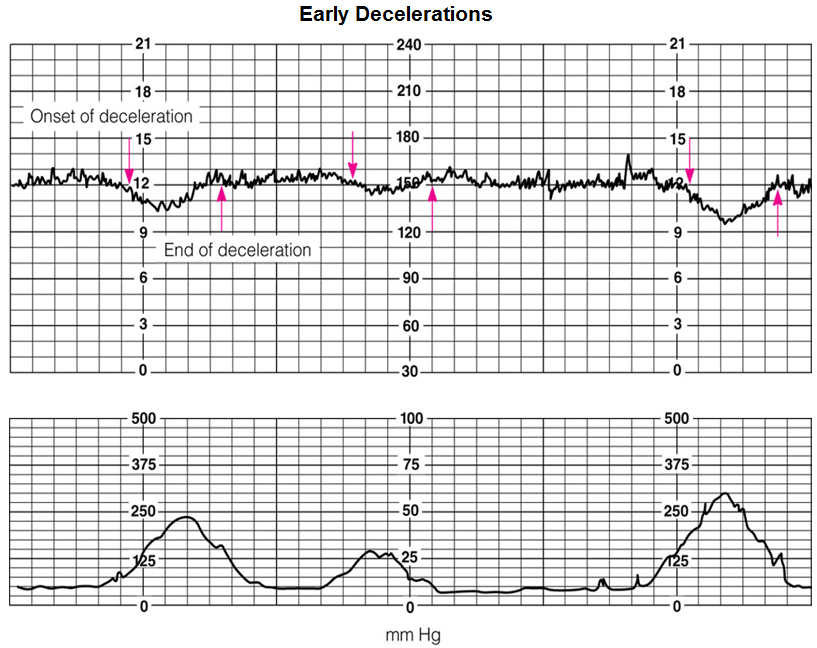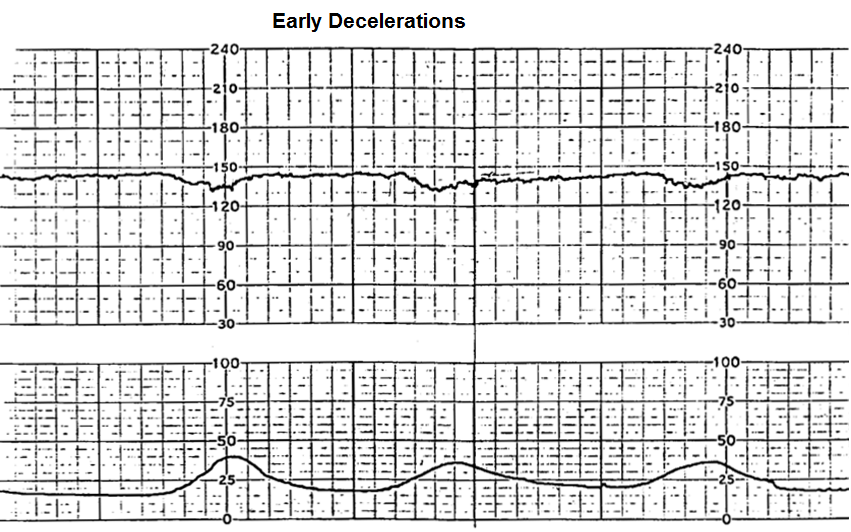Early Decelerations- Explained

Early decelerations are a benign decrease in heart rate of a fetus from the normal baseline heart rate that occurs only during contractions and signals that the fetal head is compressed during contractions.
The baby has a normal baseline heart rate. A deceleration causes a decrease in heart rate from the baseline.
Unlike late decelerations, early decelerations are rather benign and do not require intervention from a medical professional. Late decelerations are more serious and mean that the status of the fetus is compromised. It reflects impaired placental exchange, called uteroplacental insufficiency. It requires medical intervention to improve the placental blood flow and fetal oxygenation.
On the other hand, early decelerations simply mean that the baby's head is being compressed during contractions, usually during the peak of the contractions. During the peak of the contraction is the time when the baby's head normally gets squeezed the most, generally against the woman's pelvis or soft tissues, such as the cervix. Fetal head compression briefly increases intracranial pressure, causing the vagus nerve to slow the heart rate.
By the end of the contraction, the baby's heart rate returns to baseline.
Early decelerations, like late, have a gradual, rather than abrupt, decrease from the baseline.
Early decelerations are mirror images of the contractions, meaning they mimic the contraction. When the contraction occurs, some deceleration occurs. As the contraction gets stronger, the heart rate decelerates more. When the peak is of the contraction is reached, this causes the greatest deceleration (biggest drop in heart rate). Then after the peak the heart increases as the contraction gets less stronger until the contraction is over. At this point, a complete return to baseline has occurred.
Early decelerations don't cause any compromise to the status of the fetus, such as oxygenation or anything. Therefore, it requires no medical intervention.
So now that you know what early decelerations are and what causes it, let's see how to interpret them on a graph.
Below is a graph showing early decelerations.

As stated before, early decelerations pretty much mimic the contraction. So decelerations occur all along the duration of the contraction.
As the contraction begins, decelerations begin. First the decelerations are mild, but as the contraction increases in amplitude, the decelerations continue in amplitude (decreasing the heart rate). As said before, the heart rate is lowest at the peak of the contraction. After the peak when the contraction begins to get weaker, the heart rate begins to go up again. When the contraction is completely resolved, the heart rate is back to baseline.
Notice how the contractions take the shape of an upside-down parabola, or in less scientific or mathematical terms, an upside down U.
And notice how the contractions take the shape of a right-side-up parabola, or right-side-up U.
This shows how the mirror of early decelerations and contractions. It mirrors it pretty much exactly. It mirrors the inverse waveform of the contraction. So as you see an upside-down U on the contraction waveform, you will see a right-side-up U on the heart rates. So they really mirror each other inversely.
You see mmHg across the horizontal axis because contractions are measured in mmHg. The heart rate is just measured numerically. For this fetus, the baseline heart rate is about 155 beats per minute. During the peak of the contraction, you can see that the heart rate gets as low as about 132bpm. Therefore, that's a difference of 23 beats from the baseline. The rate decrease is rarely more than 30-40 bpm below the baseline. So a drop of bpm in the teens and 20s is normal.
Another graph showing early decelerations is shown below.

You can see again how the decelerations mirror the contraction waveforms during the duration of the contraction.
Again, early decelerations are benign and no medical procedure needs to be done to fix it.
Maternal position changes usually have no effect on the pattern. Since the cause of early decelerations is head compressions, you may think that if the mother
adjusts her position, it may relieve the head compression. But this usually has no effect.
Related Resources
Variable Decelerations- Explained